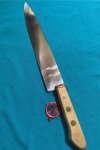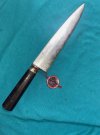I adore my
puñales, but the humble
cuchilla exerts a draw on me. I like that they are simple working tools, without the excessive ornamentation one too often finds on contemporary
cuchillos criollos. I've been lazily searching for a suitable example. Shouldn't be too difficult, they basically look like a modern kitchen knife. Except I wanted one that could conceivably have been owned by a real gaucho under different circumstances.
I chanced upon this older, supposedly German piece. Won't ever be certain of its true origins as the blade is unstamped. Still, the knife looks the part with its carbon steel blade, wooden handle, riveted construction, and lack of bolsters.
View attachment 2864463
More enchanting perhaps is this
cuchillo de campo. The knife is supposed to be unused, and maybe it is, but the blade is far from pristine. Don't see these too often though, and I couldn't resist.
View attachment 2864464














